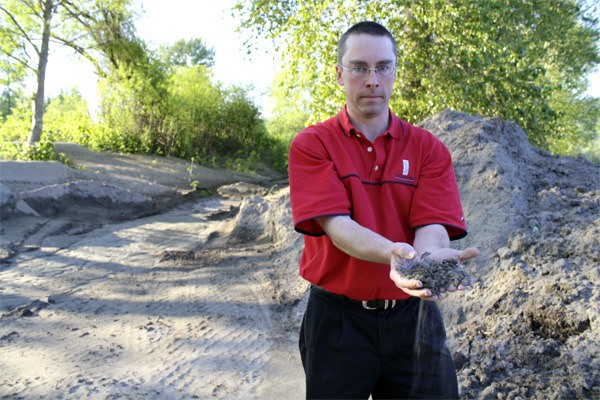Halting for every shot, Jeff Groshell calls out greetings by name to most foursomes as he drives his cart through Snoqualmie Falls Golf Course.
The course is hopping on a sunny Thursday afternoon as Snoqualmie Falls’ head pro points out the greens and fairways that he’s most proud of, blue skies and snowy Cascade views lingering over emerald grass.
“Our claim to fame is the condition,” Groshell says. In his view, Snoqualmie Falls can compete with any Valley course for the quality of its playing areas; the business lives and dies by its reputation.
But there are a few parts of his course that Groshell isn’t thrilled with: Namely, the riverside stretch along the second tee, where grass is gamely fighting up through soil devastated by three floods this winter. Not much can grow in the silty flood deposits that lie piled along the bank. One 50-yard stretch, where the river gouged five-foot-deep trenches, looks like the surface of the moon.
The second tee is the first place that gets washed out in a flood, but Groshell is not about to move it, though he’s loath for it to be photographed.
“There’s nowhere else to go,” he said. “If you want to have 18 holes, you’ve got to have place for them.”
Like several Lower Valley golf courses, Snoqualmie Falls has a handicap: Its proximity to the Snoqualmie River. Tallying floods nearly every other year for the past six years, Groshell joined the Snoqualmie Valley Preservation Alliance in its efforts to halt dam modifications at Snoqualmie Falls. His family is among several Lower Valley businesses who contributed to the group’s legal fight against the U.S. Army Corps of Engineers and Puget Sound Energy, which ended in favor of the Corps in March.
SVPA members voted in May to appeal the decision to the Ninth Circuit Court of Appeals in San Francisco, a panel of three judges. When and if they go through with filing depends on whether they raise enough money for the cost of the action, about a third of the $100,000 that was spent in the original court battle.
To Groshell, it’s not right “to just give up on it, when it’s doing what it’s doing to us.”
The object of the suit is to halt the project and force a study of downstream effects. SVPA members say the Lower Valley has seen higher-than-anticipated flood levels since the Corps’ early-2000s Snoqualmie River Flood Control project—also known as the 205 Project—including the minor floods this winter.
“We can’t imagine a fair study not showing how off everything is,” said SVPA president Geary Eppley. Flood problems have “constantly been pushed downriver…. Now, it’s upon us. If we don’t fight this one, then another will come, and another…. We need some real numbers.”
In March, Federal Judge John Coughenour ruled that the Corps appropriately followed permitting procedures in allowing Puget Sound Energy’s three-year, $200 million update, which included a widening of the river channel and lowering of the coffer dam at the Falls by four feet.
The SVPA had argued that the Corps avoided a permitting procedure that would have required more public input and a downstream study.
PSE says that impacts from the project are expected to be minimal. Their projection— that the work would raise 100-year flood levels in the Valley by about a quarter-inch—are based on work by Northwest Hydraulics consultants and, in part, on the U.S. Army Corps of Engineers study for the 205 project.
PSE Spokesman Roger Thompson would not discuss the studies used by the company to determine downstream impacts.
“Once this moved into the legal realm, we don’t get into specifics on what the studies have or have not shown,” he told the Record.
Thompson repeated the company’s stance on the Falls project as a run-of-the-river facility.
“It’s never had any marked water storage capacity,” he said. “It hasn’t in the past and it won’t in the future.”
Thompson said there was “exhaustive review, public participation, study, analysis, public outreach” during the 17-year relicensing procedure.
“We’ve heard people say there needs to be a comprehensive study,” he added. “Should we be studying the effects of residential development in the upper reaches of the Valley? It’s not something we have the ability to study.”
Eppley said the group has found no evidence of any downstream study. He claims the permitting process was carefully crafted to avoid such a study.
“The Corps and PSE acted illegally in stretching the application of the Nationwide Permitting process to cover the PSE project and we aim to prove this in appeal,” he told the Record.
“The Corps and the people who manage the river should look out for everybody,” he said. “People who want to come out here, go to the farms, play the golf courses, are going to lose that if nothing’s done. All this stuff is going to go away.”
Benefit event
To raise the anticipated $30,000 or more in legal fees for their appeal, the SVPA plans a benefit auction, dinner and barn dance, “Hoedown in the Valley,” 5 to 10 p.m. Saturday, June 4, at Acacia Farm in Carnation.
The event will include live music, a gourmet pig roast and barbecue. Tickets are $55 per person, or $100 per couple. To learn more, visit www.svpa.us.



